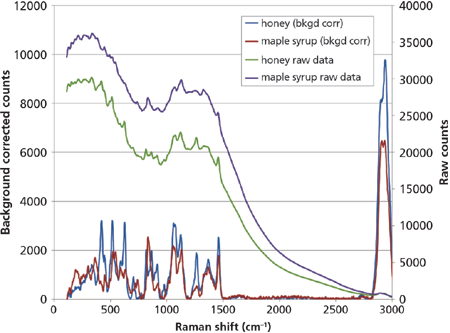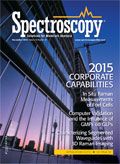Raman Spectroscopic Study of Sugars in Common Liquid Sweeteners
Raman spectroscopy has strong potential in the identification and quantification of sugars in concentrated aqueous solutions in the food industry.
A variety of liquid sweeteners greet consumers when they shop for toppings for toast and pancakes. At the high end of the price range one can find Grade A maple syrup and varietal honey. The predominant sugars in these aqueous solutions are sucrose and a mixture of glucose and fructose, respectively. Raman spectroscopy has been used numerous times in the literature to make measurements pertaining to mono- and disaccharide mixtures. Topics from water content in solutions to honey provenance have been reported. This application note demonstrates preliminary work on a product purity measurement for both maple syrup and honey.
Experimental Conditions
The Raman measurements discussed in this application note were made with a TSI | Chemlogix ProRaman-L instrument with 250 mW of 785 nm laser excitation and a spectral range of 100–3300 cm-1. The spectra were collected with a 3-s acquisition period and 20x averaging. The raw spectra, presented in Figure 1 (secondary y-axis), were then corrected for the native fluorescence in the material with the TSI standard background correction algorithm (results plotted on primary y-axis). Honey and Grade A maple syrup samples were presented to the system in a standard quartz cuvette held inside the vial-holder accessory.

Figure 1: Raw and processed Raman spectra of honey and maple syrup.
Results
The raw spectra of the two materials show clear differences in the background fluorescence excited at 785 nm as well as smaller but equally obvious differences in the Raman scattering signals that are present on top of the broad fluorescent curve. These differences become more pronounced when the broad fluorescence background is removed, and the spectrum is corrected for system response. The materials exhibit very clear differences in the region from 510–540 cm-1 have been assigned to a C–C–O bending mode (1). C–C and C–O stretch vibrations are also observed in the region near 1050 cm-1. Additionally, a feature revealed only by the signal correction is that honey has significantly more signal in the region associated with CH stretches than does the maple syrup. The sugars in maple syrup are dominated with sucrose, which is a fructose-glucose disaccharide, but all the CH bonds are retained in the disaccharide. Monitoring this feature could provide a means to determine the concentration of the sugars in aqueous solution.
Conclusions
This brief application note discusses the utility of Raman spectroscopy in the differentiation of sugars in liquid materials. Although this work was performed in a quartz cuvette, it could be extended to measurements in plastic and glass containers, such as those in which these materials are sold.
Reference
(1) S. Söderholm, Y.H. Roos, N. Meinander, and M. Hotokka, J. Raman Spectrosc. 30, 1009–1018 (1999).

TSI, Incorporated
500 Cardigan Road, Shoreview, MN 55126
tel. (800) 874-2811, fax (651) 765-3725
Website: www.tsi.com
